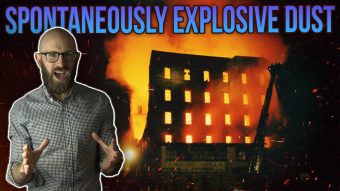
“Then each floor above the basement became brilliantly illuminated, the light appearing simultaneously at the windows as the stories ignited one above the other. Then the windows bust out, the walls cracked between the windows and fell, and the roof was projected into the air to great height, followed by a cloud of black smoke, through which brilliant flashes resembling lightening passing to and fro.”
This blaze soon spread to the neighbouring Diamond and Humboldt mills, touching off further explosions and fires. So intense was the heat that firefighters were unable to approach the blazing buildings, causing firefighting efforts to drag on through the night. When the smoke finally cleared, eighteen people lay dead and six mills in ruins, reducing the city’s flour production capacity by nearly one half overnight. Known as the Great Mill Disaster, the incident was one of the greatest industrial accidents in Minnesota history. But what had actually caused the disaster? Extraordinarily, these blasts, which shattered granite and concrete and levelled some of the world’s largest and most modern industrial buildings, were caused not by dynamite, TNT or any other conventional explosive, but rather the seemingly benign substance these mills were built to produce: flour. For when finely divided materials like flour, sawdust, and coal dust combine with sufficient air, they form a highly-explosive mixture that has levelled dozens of factories and mines and killed thousands of people over the last 200 years. This is the fascinating – and terrifying – science and history of dust explosions.
Dust explosions can occur in a wide variety of materials, including grain and flour, corn starch, paper, sugar, cocoa, coffee, coal, sawdust, tobacco, and powdered metal and plastic. Under normal circumstances, these substances are fairly benign and will not combust easily. However, if these materials are ground into fine particles with, say, a diameter of 50 micrometers, the energy needed to ignite each individual particle goes down dramatically. And if these particles are then suspended in air, the resulting increase in the oxidizer-to-fuel ratio creates a volatile mixture that, if ignited by a stray spark, flame, or ember, will very rapidly burn or deflagrate. This effect becomes even more violent if more powerful oxidizers such as pure oxygen or nitrous oxide are present. The lowest concentration of dust in air at which this will occur is known as the lower explosive limit or LEL; below this concentration, there is insufficient fuel to support combustion. In most industrial environments, a dust concentration 25% below the LEL is considered safe. By contrast, above the upper explosive limit or UEL, there is insufficient oxidizer – i.e. atmospheric oxygen – to support combustion. In between these two limits the the optimal explosive concentration or OEC at which the explosive power of the deflagration is greatest. This typically occurs at around 10x the LEL. All three of these values, however, depend on the specific fuel. For example, the LEL for grain dust or flour is around 51 grams per cubic metres of air.
Another key condition for a dust explosion is containment, which prevents wind from dispersing the dust particles below the LEL and allows the pressure wave from the explosion to travel freely throughout the suspended dust mixture. Unlike the shock wave from a high explosive like TNT, the pressure wave from a dust explosion travels at subsonic speeds, hence why such explosions are classed a deflagrations rather than detonations. Surprisingly, however, this relatively slow speed of propagation is exactly what makes dust explosions so extraordinarily destructive. Typically, dust explosions begin in smaller confined spaces like grinders or conveyors, set off by overheated equipment or static electricity. This initial deflagration is known as a primary explosion, and can travel at speeds of up to 300 metres per second. However, if proper safety mechanisms are in place, such explosions are typically contained and do not propagate far beyond their ignition point. However, if a large amount of dust has accumulated in the surrounding area – as can happen when dust abatement systems are absent or poorly maintained – then the pressure wave from the primary explosion can stir up this dust and mix it with the surrounding air, creating an explosive fuel-air mixture through which the explosion can propagate. This is known as a secondary explosion, and these are responsible for the majority of dust explosion disasters. Unlike high explosives like TNT, which generate a single blast wave from a single point source, dust explosions create multiple blast wave fronts as they propagate, which can rapidly raise the pressure inside a structure to as high as 550 kilopascals. This pressure is also sustained over a longer period than with high explosives, allowing dust explosions to inflict greater damage to even heavily-reinforced concrete structures.
This destruction can be truly staggering. For example, on August 9, 1919, a 79,000 cubic metre concrete grain elevator in Port Colborne, Ontario was levelled by an explosion which sent debris flying more than 3 kilometres away, killed 10 people and injured 16. The blast also completely destroyed a grain barge and the Canada Steam Lines steamer Quebec anchored nearby. More recently, on February 7, 2008, an Imperial Sugar refinery in Port Wentworth, Georgia, was rocked by a massive explosion that completely shattered two 30 metre tall, half-metre thick reinforced concrete storage silos, demolished 12% of the 650,000 square metre facility, and left a large part of the rest dangerously unstable. The blast also killed 14 people and injured 36 others. Many of these injuries were horrific, with paramedics describing victims with “skin dripping off of them.” As is typically the case in such disasters, the cause of the blast was traced to lax safety and cleanliness practices, which allowed dangerous amounts of extremely fine sugar dust to accumulate throughout the facility. Indeed, the dangers had been known about since 1958, but had been ignored by the refinery’s management for fifty years. The explosion itself was sparked by an overheated bearing in a conveyor belt; due to a lack of dust abatement equipment, this primary explosion quickly propagated throughout the rest of the facility.
But even these disasters pale in comparison to those which have occurred in coal mines, where the combination of extremely combustible fuel and a confined environment has resulted in truly horrific casualties. One of the worst such disasters took place on September 19, 1921 at the Mount Mulligan coal mine in Queensland Australia. The explosion, which could be heard 30 kilometres away, was so powerful it ripped giant 1-ton cable drums from their concrete footings and launched them 40 metres away from the mine entrance. All 75 workers inside the mine at the time were killed instantly, with only 11 of the bodies being recovered. The subsequent investigation revealed that the disaster was caused by a combination of complacency and carelessness. Firstly, as the mine had no history of “firedamp” – a collective term for flammable gases like hydrogen and methane – miners worked by the light of open flames instead of safety lamps designed nearly a century earlier to prevent gas explosions. Secondly, the levels of coal dust inside the mine were allowed to reach explosive levels. And finally, on the morning of September 19, an explosive charge was detonated atop a large mass of machine-dug coal in order to pulverize it. Instead, the blast stirred up and ignited the coal dust inside the mine, setting off a massive dust explosion.
But the deadliest dust explosion of all time took place in 1942 at the Benxihu Colliery, in what was then the Japanese-controlled puppet state of Manchukuo in Manchuria, northern China. The Japanese owners of the mine treated the Chinese workers as little more than slave labour, frequently beating and starving them and forcing them to work brutal, 12-hour shifts. When a coal-dust explosion ripped through the mine on April 26, 1942, the Japanese, in an effort to snuff out the ensuing fire, turned off the ventilation system and sealed the entrance to the mine, trapping all the workers inside. The resulting death toll was a staggering 1,549 people, making it the single worst mining disaster in history.
While most dust explosions occur in confined spaces, fine burning particulates can also cause considerable damage out in the open. For example, on June 27, 2015, a water park called Formosa Fun Coast in New Taipei City, Taiwan, held a party called Color Play Asia, inspired by the Hindu religious festival of Holi. As part of the festivities, a swimming pool was drained to create a dance floor for around 1,000 people, while coloured corn starch was fired out of air cannons over the crowd – and by now I’m sure you can all see where this is going. The powder formed a large cloud of fine suspended particles which quickly breached the lower explosive limit and ignited, creating a fireball that swept through the crowd. Immediately, staff members rushed in with carbon dioxide fire extinguishers to put out the blaze, but this only further stirred up the dust and caused the fire to spread. In the end, 496 people were seriously injured and 15 killed, with many of the victims suffering third degree burns over more than 80% of their bodies.
Dust explosions in spaces like flour mills, coal mines, and other industrial facilities can be prevented using a variety of methods, the simplest of which is to install dust collection systems on equipment such as grinders and conveyors to prevent dust from accumulating to dangerous levels. Such equipment is also typically fitted with flame arrestors or vents to prevent primary explosions from propagating beyond their source and triggering a secondary explosion or “inertized” using non-oxidizing gases like nitrogen or argon. Water-spraying systems can also be used to make dust too humid to ignite in the first place, while some mines place trays of inert rock dust around the tunnels such that in the event of a primary explosion, this dust will be stirred up and dilute the explosive dust below its Lower Explosive Limit, preventing a secondary explosion from being triggered. But while such safety measures and tighter regulations have greatly decreased the incidence of industrial dust explosions, thanks to rampant negligence and cost-cutting in multiple industries, they still continue to occur at an alarming frequency. Indeed, between 1980 and 2005, the United States Chemical Safety Board recorded 281 combustible dust incidents in the United States alone, which killed 119 workers and injured 718.
Due to the unique destructive properties of dust explosions, militaries around the world have harnessed this phenomenon to create a class of weapons known as fuel-air or thermobaric bombs. Such weapons typically consist of a casing packed with liquid or solid powdered fuel, along with a conventional high-explosive “scatter charge”. When detonated, this charge vaporizes and scatters the fuel, which mixes with the surrounding air to form an explosive mixture. In some bombs, a secondary charge is needed to ignite this mixture, while in others the fuel is pyrophoric and ignites spontaneously on contact with atmospheric oxygen. On a per-mass basis, thermobaric weapons are more powerful than conventional explosives because they do not need to carry their own oxidizer, allowing more fuel – and thus more explosive energy – to be contained in a smaller casing. The blast wave from thermobaric weapons is more powerful and longer lasting than that from conventional explosions, and can reach temperatures as high as 2,000 degrees celsius. The explosion also instantly consumes all available atmospheric oxygen in a given area, hence the common nickname of “vacuum bomb” for such weapons. This makes thermobaric weapons far more effective against troops sheltered from regular explosive blasts, such as in foxholes, trenches, bunkers, and caves. Indeed, during the 2001 invasion of Afghanistan, the US military used thermobaric weapons as well as more conventional BLU-82 “Daisy Cutter” bombs to clear out cave complexes in Gardez and Tora Bora thought to be sheltering Al Qaeda and Taliban fighters. More controversially, thermobaric weapons have been used against civilians by Russian forces during the two Chechen wars from 1994 to 2009, by Syrian government and Russian forces during the Syrian civil war, by the government of Myanmar, and again by Russia during the ongoing war in Ukraine. The horrific injuries inflicted by such weapons have led to calls for them to be outlawed. As a 2000 report by Human Rights Watch Inc. states:
“The [blast] kill mechanism against living targets is unique—and unpleasant. … What kills is the pressure wave, and more importantly, the subsequent rarefaction [vacuum], which ruptures the lungs. … If the fuel deflagrates but does not detonate, victims will be severely burned and will probably also inhale the burning fuel. Since the most common FAE fuels, ethylene oxide and propylene oxide, are highly toxic, undetonated FAE should prove as lethal to personnel caught within the cloud as with most chemical agents.”
Despite this, thermobaric weapons remain legal in warfare provided they are used against legitimate military targets.
The prolonged, higher-pressure blast wave produced by thermobaric warheads also make them useful for taking out small buildings, bunkers, and other structures, the higher energy density of these weapons allowing them to punch far above their weight. For example, during the 2003 invasion of Iraq, the U.S. Marines made extensive use of the Mk 80 Mod 0 Encased Novel Explosive warhead for the Mk 153 Shoulder-Launched Multipurpose Assault Weapon or SMAW, an 83.5 mm portable rocket launcher introduced in 1984. Despite containing only 2 kilograms of fuel, the SMAW-NE is capable of completely levelling a 1 or 2 storey masonry building.
Perhaps unsurprisingly, the most powerful non-nuclear bomb ever developed is the Russian Aviation Thermobaric Bomb of Increased Power or ATBIP. Introduced in 2007, the ATBIP is also known as the “Father of All Bombs” or FOAB in reference to the American GBU-43/B Massive Ordnance Air Blast or MOAB, nicknamed the “Mother of All Bombs.” Unlike the MOAB, which contains 8.5 tons of conventional H-6 high explosive, FOAB contains only 6 tons of ethylene oxide and aluminium powder slurry, dispersed and ignited by a small explosive charge. Despite this, FOAB has an explosive yield equivalent to 44 tons of TNT compared to only 11 tons for MOAB, with a blast radius and temperature twice as high.
Yet despite their awesome explosive potential, thermobaric weapons still suffer from a number of limitations. Strong winds, for example, can scatter and dilute the fuel before it has a chance to ignite, greatly reducing the explosive yield. And during the invasion of Iraq, it was found that SMAW-NE rockets could not penetrate masonry walls, requiring a hole to be made with a conventional explosive warhead before the thermobaric weapon could be brought to bear. Nonetheless, under the right conditions, thermobaric weapons – and the industrial dust explosions that inspired them – can be horrifyingly destructive, reminding us of the incredible energy contained in even the most seemingly benign materials. So the next time someone tells you your baking is “the bomb,” you now know that this might literally be true.
Expand for References
Mill City Museum and Site of “The Great Mill Disaster”, Atlas Obscura, https://www.atlasobscura.com/places/mill-city-museum-site-great-mill-disaster
The Explosion That Changed Milling, General Mills, May 2, 2012, https://www.generalmills.com/news/stories/the-explosion-that-changed-milling
Nathanson, Iric, Washburn A Mill Explosion, 1878, MNopedia, https://www.mnopedia.org/event/washburn-mill-explosion-1878
Nathanson, Iric, Looking Back at the 1878 Washburn A Mill Explosion, Minnesota Post, June 6, 2013, https://www.minnpost.com/minnesota-history/2013/06/looking-back-1878-washburn-mill-explosion/
5 Killed, 14 Injured in Canadian Blast, The Washington Herald, August 10, 1919, https://chroniclingamerica.loc.gov/lccn/sn83045433/1919-08-10/ed-1/seq-1/#
Elevator Explosion in Canada Kills Five Men, The Daily Ardmoreite, August 10, 1919, https://ift.tt/vFGhqkD
Czapski, Donat, A Sugar Dust Explosion in an Enclosed Conveyor Caused by Many Years of Neglect, Wolff Safety and Innovations, https://www.grupa-wolff.com/a-sugar-dust-explosion-in-an-enclosed-conveyor-caused-by-many-years-of-neglect/
Mount Mulligan Mine Disaster, Australasian Mine Safety Journal, June 24, 2019, https://www.amsj.com.au/mount-mulligan-mine-disaster/
The World’s Worst Mining Disasters, Mining Technology, May 15, 2014, https://www.mining-technology.com/features/feature-world-worst-coal-mining-disasters-china/
Grain Dust Explosions, Ag Safety and Health, May 17, 2019, https://ag-safety.extension.org/grain-dust-explosions/
Dust Explosion Hazard, Nova Scotia Labour and Advanced Education, https://novascotia.ca/lae/healthandsafety/documents/DustExplosionHazardAlert.pdf
Jones, Carol, Preventing Grain Dust Explosions, Oklahoma State University, February 2017, https://extension.okstate.edu/fact-sheets/preventing-grain-dust-explosions-2.html
Grau, Lester & Smith, Timothy, A ‘Crushing’ Victory: Fuel-Air Explosives and Grozny 2000, Foreign Military Studies Office, August 2000, https://web.archive.org/web/20130508052201/http://fmso.leavenworth.army.mil/documents/fuelair/fuelair.htm
Atherton, Kelsey, Thermobaric Bombs and Other Nightmare Weapons of the Syrian Civil War, Popular Science, October 5, 2016, https://www.popsci.com/thermobaric-bombs-and-other-nightmare-weapons-syrian-civil-war/
Seidel, Jamie, ‘Father of All Bombs’: Russia’s Brutal Weapon, News.com, February 27, 2022, https://www.news.com.au/world/europe/father-of-all-bombs-russias-brutal-weapon/news-story/45a3fda64cc7d32d389c06749809b4bc
The “Father” of All Bombs, Defense Tech, https://ift.tt/jMJ2SsZ
The post The Strange and Frightening Phenomenon of Dust Explosions appeared first on Today I Found Out.



0 comments:
Post a Comment
Please ,
Don't enter span link